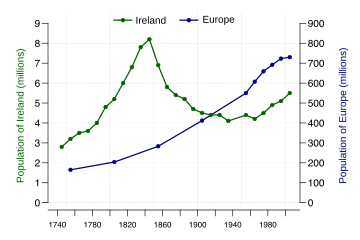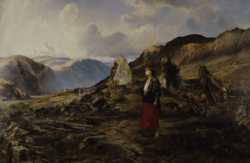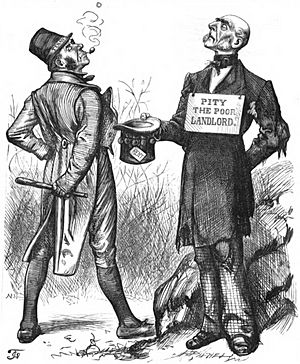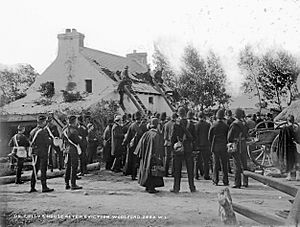Land War facts for kids
Quick facts for kids Land War |
|||
|---|---|---|---|
| Part of Irish Home Rule movement | |||

An Irish family in Moyasta, County Clare being evicted c. 1879
|
|||
| Date |
|
||
| Caused by |
|
||
| Goals |
|
||
| Methods | Rent strikes, boycotts, political demonstrations | ||
| Resulted in |
|
||
| Parties to the civil conflict | |||
|
|||
| Lead figures | |||
|
|
|||
The Land War (Irish: Cogadh na Talún) was a time of big protests and changes in rural Ireland. It started in 1879 when Ireland was part of the United Kingdom. This period saw farmers fighting for better rights and fairer treatment from landlords.
The main goal of the Land War was to get "fair rent, free sale, and fixity of tenure" for tenant farmers. This meant:
- Fair rent: Paying a reasonable price to use the land.
- Free sale: Being able to sell the improvements they made to their farms to the next tenant.
- Fixity of tenure: Being able to stay on their land without being easily evicted.
Eventually, the farmers also wanted to own the land they worked on. Groups like the Irish National Land League led these efforts. Over time, new laws called Land Acts were passed. These laws helped farmers buy their land from landlords.
Contents
Why the Land War Started

In the 1800s, most people in Ireland lived in the countryside. A few rich people, called absentee landlords, owned most of the land. Many of these landlords didn't even live in Ireland. In 1870, about half of Ireland was owned by just 750 families.
Landlords collected huge amounts of money in rent. They often didn't put much money back into the land. This caused problems between landlords and the farmers who rented from them. Farmers wanted more control over their farms and to feel secure.
After the terrible Great Famine (1845–1849), many poor farmers died or had to leave Ireland. This freed up land that bigger farmers could buy. In 1850, a group called the Tenant Right League started. They wanted fair rent, free sale, and fixity of tenure.
A new law, the Landlord and Tenant (Ireland) Act 1870, was passed. But it actually made things worse. Landlords tried to get around the rules, and farmers formed groups to protect themselves.
In the late 1870s, there were more and more disputes over land. At the same time, fewer people were leaving Ireland. This meant more people were staying and getting involved in the protests.
In 1879, western Ireland was hit by another famine. Heavy rains, bad harvests, and low prices meant many small farmers were hungry and couldn't pay their rent. Some landlords helped, but others refused. This difficult situation, combined with strong leaders, led to a powerful movement.
Key Events and Groups
The Land League (1879–1881)
The Land War officially began on April 20, 1879, at a large meeting in Irishtown, County Mayo. Michael Davitt and James Daly helped organize it. Thousands of people came to protest high rents. Many farmers were being threatened with eviction because they couldn't pay.
Leaders like Charles Stewart Parnell, a rising political star, joined the movement. He spoke at meetings and helped unite different groups. At first, the movement included both Catholic and Protestant farmers.
On October 21, 1879, the Irish National Land League was formed in Dublin. Parnell became its president. The League's main slogan was "the land for the people." For most farmers, this meant owning their own land. For others, it meant getting bigger farms.
The Land League became very strong. The government set up the Irish Land Commission in 1881. This group had the power to help farmers buy their land.
Stopping the Land League (1881–1882)

In 1881, the government passed the Land Law (Ireland) Act 1881. This law gave farmers more rights, but it didn't stop evictions. Parnell and other leaders, like William O'Brien and John Dillon, spoke out against the law. They were put in Kilmainham Jail in October 1881.
While in jail, they issued the No Rent Manifesto. This called for farmers across Ireland to stop paying rent until the leaders were released. The government then tried to shut down the Land League.
However, many farmers were more interested in using the new Land Act than in stopping rent payments completely. Disputes over land actually increased while Parnell was in jail.
In April 1882, Parnell made a deal with the government, known as the Kilmainham Treaty. He agreed to stop the "No Rent" campaign and work against land disputes. In return, he and other leaders were released from jail.
After the Land League was stopped, Parnell started a new group called the Irish National League in October 1882.
The Plan of Campaign (1886–1891)
From 1886 to 1891, a new wave of protests called the Plan of Campaign began. This happened because of droughts and economic problems. Farmers on an estate would meet and decide what they thought was a fair rent. If the landlord refused this lower rent, the farmers would pay the money into a special fund instead.
These rent strikes targeted landlords who were already struggling financially. One main target was Lord Clanricarde, who had evicted many tenants.
The protests sometimes led to violence, like the Mitchelstown massacre in 1887. Some politicians, like William O'Brien, were even put in jail for their involvement.

Later Protests
Between 1906 and 1909, there was another period of unrest called the Ranch War. Small farmers wanted more land and for large grazing farms to be broken up. They argued that many of these large farms had been created after the famine by evicting small farmers.
This campaign involved actions like moving cattle off large farms, holding public meetings, and boycotting. It was most intense in areas where large farms and small, struggling farms were side-by-side.
During the Irish War of Independence (1918–1922), many people in western Ireland still had very small farms. Soldiers who fought for Ireland were also promised land. In 1919–1920, there were many cases of people taking over land in western Ireland.
After the Anglo-Irish Treaty that ended the War of Independence, the land issue was not directly addressed. This led to more unrest during the Irish Civil War. New Land Acts in 1923 and 1933 finally led to a "dramatic redistribution" of large farms to small farmers and those without land.
Tactics Used

Land Courts
Some local groups of the Land League set up their own "courts" in 1880 and 1881. These courts were similar to official British courts. They would hear cases, call witnesses, and make judgments. They aimed to enforce the Land League's rules, like not paying rent without reductions or not taking over land from evicted tenants.
These courts were seen as a "shadow legal system" by some. The British government found them very challenging because they showed that the Land League's rules were becoming more powerful than official laws.
Boycott
One of the most famous tactics used by the Land League was the boycott. This tactic was first used against "land grabbers"—people who took over land from evicted tenants.
Charles Stewart Parnell suggested that instead of violence, people should simply avoid anyone who took over evicted land. This meant shunning them in the community. This tactic was later used against landlords too.
The term "boycott" was created after a successful campaign against a land agent named Charles Boycott in County Mayo. People refused to work for him or sell him supplies. Boycott was forced to leave the country. The tactic then spread across Ireland and became famous worldwide.
Boycotting made life very difficult for the victims. They were isolated from the community. While its effectiveness is debated, the idea of a boycott became a powerful tool for non-violent protest.
Rent Strikes
Farmers also used rent strikes to pressure landlords to lower rents. When farmers withheld their rent, the money often went into a "defence fund." This fund helped pay for legal help in eviction cases and supported families who had been evicted.
Rent strikes could also involve delaying payments, making it hard for rent collectors, or even re-occupying farms that had been rented to new tenants after an eviction.
Land Laws
The problems over land in Ireland were eventually solved by a series of Irish Land Acts. These laws started in 1870 with changes to rent rules. The Irish Land Commission was set up in 1881 to help set fair rents.
The Ashbourne Act of 1885 began a process that allowed tenant farmers to buy their land. This was greatly expanded by the Land Purchase (Ireland) Act 1903. This law gave Irish tenant farmers a government-backed right to buy their land.
These laws allowed farmers to gain strong rights over their rented land. Then, they could buy their land from landlords using loans from the UK government and the Land Commission.
The Land Acts were very successful in changing who owned land. In 1870, only 3% of Irish farmers owned their land, while 97% were tenants. By 1929, this had completely changed: 97.4% of farmers owned their farms!
However, the Land Acts weren't the only reason for this change. World War I and the Irish fight for independence also helped lead to land being sold. While the Land Acts helped many, the biggest winners were often the middle-class farmers.



